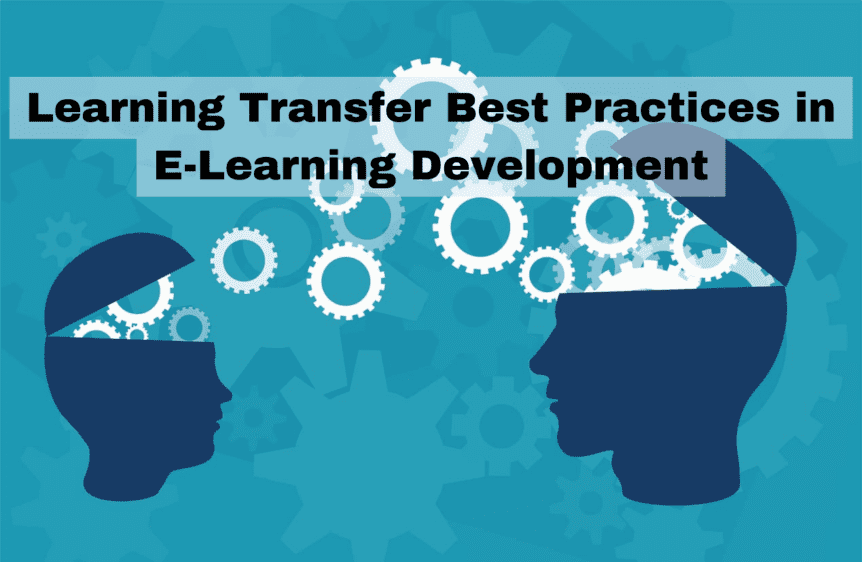Learning Transfer Best Practices in E-Learning Development
Learning transfer is a key objective for most e-learning courses. It involves employees applying what they have learned in the workplace and maintaining that change over time. How do you ensure learning transfer is successful when developing a new e-learning course?
A good starting point is to understand the various influences that can impact learning transfer. Those influences include:
- What the learner brings to the process, including the learner’s current abilities, motivation to learn, motivation to change, past experience, and individual differences.
- Preparation work, including how the training is “sold” to learners to ensure effective buy-in.
- When the training takes place, as timing can impact engagement and motivation levels. Just-in-time training is a good example, as it involves learners completing an e-learning course when they most need the new skill or information. In these situations, levels of learning transfer will be high, at least in the short term.
- The relevance and relatability of the e-learning content, i.e., can the learner connect what they have learned to their day-to-day experience?
- The type of problems the training aims to address. For example, does the training have relevance day-to-day or is it focused on situations that are relevant but novel, infrequent, or changeable?
Learning Transfer Best Practices
Objectives
Understand your objectives and what you want to achieve with the training. What behaviours do you want to change and what does success look like?
Remove Obstacles
It is essential to identify and remove obstacles that might prevent the learner from applying their new skills or knowledge in the workplace. Is the work environment ready, for example, and do learners have the tools they need? Have policies or procedures been updated?
Involve Managers
Managers are crucial to learning transfer as they will create the work environment and provide the support and encouragement to employees that is needed. Therefore, getting buy-in from managers is essential.
This could include making sure managers have the knowledge and support they need to promote the behavioural changes you want to achieve. Managers might need training themselves. It is also important to ensure management priorities are aligned with training objectives.
Peer Support
Employees might not use their new skills or knowledge because they don’t get sufficient support from peers. This should be anticipated, and measures put in place to maximise buy-in across the organisation.
Learner Buy-In
Manager and peer buy-in to the process is important, but learner buy-in is just as essential. You need to make sure learners are ready for the training and communicate to them why the training is important.
It is often helpful to address and appeal to learner motivations while clearly defining your goals. You should also ensure learners have a sufficient base level of knowledge and skills to successfully complete the course.
Clear Expectations
Make your expectations as clear as possible. What do you want to see happen as a result of the training course? What behaviours do you want to see change? What performance improvements do you want to see?
It is also beneficial in many situations to set goals for learners – behavioural change and/or performance goals.
Relevant Content
Making the content in your e-learning course as relevant to individual learners as possible is good practice generally, plus it helps with learning transfer. In brief, there should be a clear link between what is being taught and the learner’s everyday experience.
Practice Elements
Include learning transfer elements in your e-learning course, especially those that give learners the opportunity to practice and test their knowledge/abilities. Scenarios and practice activities are good examples, as are quizzes.
AI Tutor
Including an AI tutor in your e-learning courses will help learners get a deeper understanding of the topic as they can ask the questions they want when they want to ask them. AI tutors make e-learning more relevant and personalised to individual learners.
Refresher Material
In many situations, it is beneficial (and sometimes essential) to create follow-up and refresher material including, where relevant, refresher e-learning courses. Learners can go through these courses in the months after they complete the initial course to fill in any gaps and increase their confidence levels.
Create Next-Stage Content
There are also situations where creating next-stage e-learning content is beneficial. This is content that advances the knowledge and skills of learners, increasing their capabilities and further embedding the transfer of learning to day-to-day work practices.
Update Courses
Learners can lose confidence in the training content if they find it is inaccurate, especially if they discover this information when they are trying to put the new skills or knowledge into practice in a real-world work environment. Therefore, you should make sure your e-learning courses and other training materials are kept up to date.
Think About Learning Transfer from Day One
All the above tips and best practices are best achieved by thinking about learning transfer from the start of the e-learning development process. This will enhance the quality of the course that you produce while also improving the overall process, including those elements that take place before learners begin the course and the elements that occur after.

